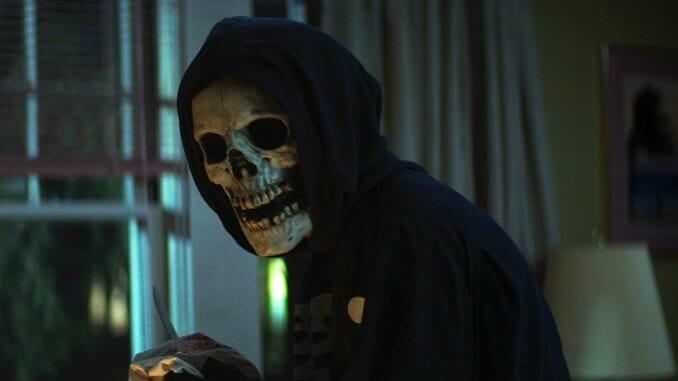Netflix’s R.L. Stine Horror Trilogy Is Off to a Great Start with Fear Street: 1994
Photos via Netflix
The two theatrically released adaptations of author R.L. Stine’s Goosebumps series of children’s horror books, in 2015 and 2018, disappointed some fans of the horror genre with their broad accessibility and lack of spooky bonafides. When you get right down to it, however, the Goosebumps films delivered exactly the sort of family friendly moviegoing experience that pretty much anyone should have been expecting from the series, especially if they’d ever read the source material. Goosebumps chapter books—they can’t really be called “novels”—were always a lighthearted traipse through the macabre, flirting with self-referentiality and capped by silly twist endings right out of the cheesier moments of The Twilight Zone. Not even the most horror-reticent child ever had nightmares as a result.
Fear Street, on the other hand, is something else entirely. Netflix’s new, three-part adaptation of Stine’s lesser-known book series of the same name, which was aimed at teenage readers rather than younger kids, dispenses entirely with the idea of reining in its bloodier impulses. It’s as surprisingly vicious as it is ambitious, kicking off its trilogy in fine style with the propulsive first installment titled Fear Street Part One: 1994, which hits the streamer on July 2, 2021. Both loving tribute to the genre and savvy reinvention, it’s an impressive (and attractive) sophomore effort from director Leigh Janiak, who directed all three interconnected installments, including the upcoming Fear Street: 1978 (releasing July 9) and Fear Street: 1666 (releasing July 16).
To the most seasoned horror geeks in the house, Janiak’s success here may not be as much of a surprise, as her underrated 2014 debut Honeymoon starring Rose Leslie was a deeply unnerving and tightly directed clinic on suspense, with no shortage of gross-out payoff. The real question was if that Janiak would show up here, as one doesn’t exactly expect a Netflix horror film adapted from a YA book series to echo the kind of transgressive body horror seen in Honeymoon. The results, however, are more genuinely bloody and less compromising than many will be expecting.
Fear Street: 1994 kicks off its action by introducing us to the town of Shadyside, an unfortunate and luckless place most famous for the penchant it seems to bear for the occasional psycho bloodbath. For decades, or even centuries, it seems as if residents of Shadyside occasionally “snap,” embarking on over-the-top rampages that evoke the spree killings of classic slasher villains. Interestingly, the film wastes absolutely no time in explaining to us exactly why this occurs, cementing from its opening credits (and then again in the first scene, in case you missed it) that a witch named Sarah Fier executed in the 1600s has reached out across space and time, through the centuries, to curse Shadyside to an unending cycle of violence.
That time-hopping conceit gives Fear Street: 1994 (and presumably the upcoming installments) all the license they need to really luxuriate in their horror genre tributes, which come in formats both obvious and significantly more subtle. Maya Hawke’s appearance in the opening of 1994 cements the obvious Scream comparisons for this installment in particular, as she’s immediately in the “Drew Barrymore” role, in a sequence that includes ringing phones, a masked, black-robed figure, and a very Scream-like chase sequence. 1994 is rife with references to many other horror films as well, though, from Poltergeist and Blair Witch to Evil Dead, Flatliners, Friday the 13th and It Follows. It even draws inspiration from some truly under-the-radar entries, such as Scott Spiegel’s underrated (and very gory) 1989 slasher Intruder, which sees one of its kills replicated here in gooey fashion.
-

-

-

-

-

-

-

-

-

-

-

-

-

-

-

-

-

-

-

-

-

-

-

-

-

-

-

-

-

-

-

-

-

-

-

-

-

-

-

-








































